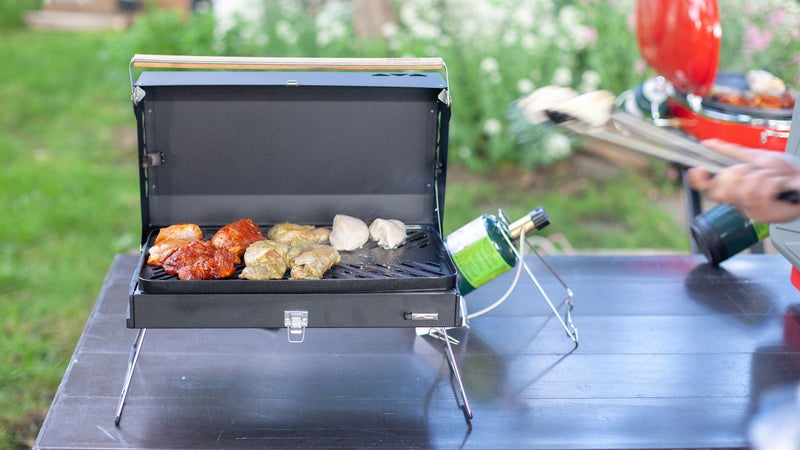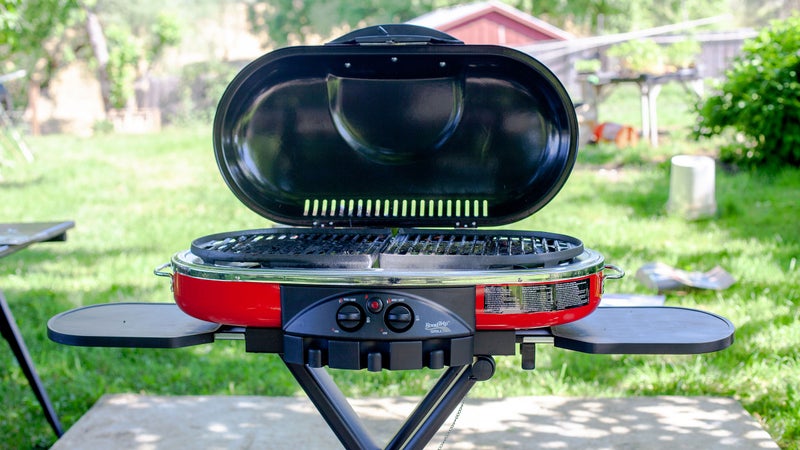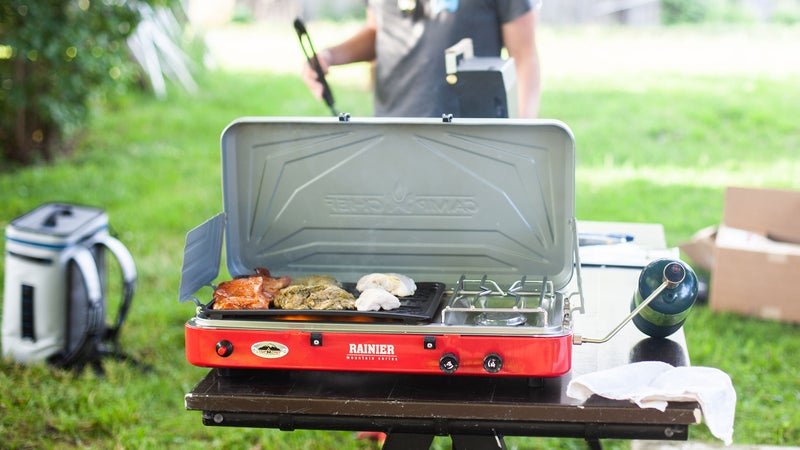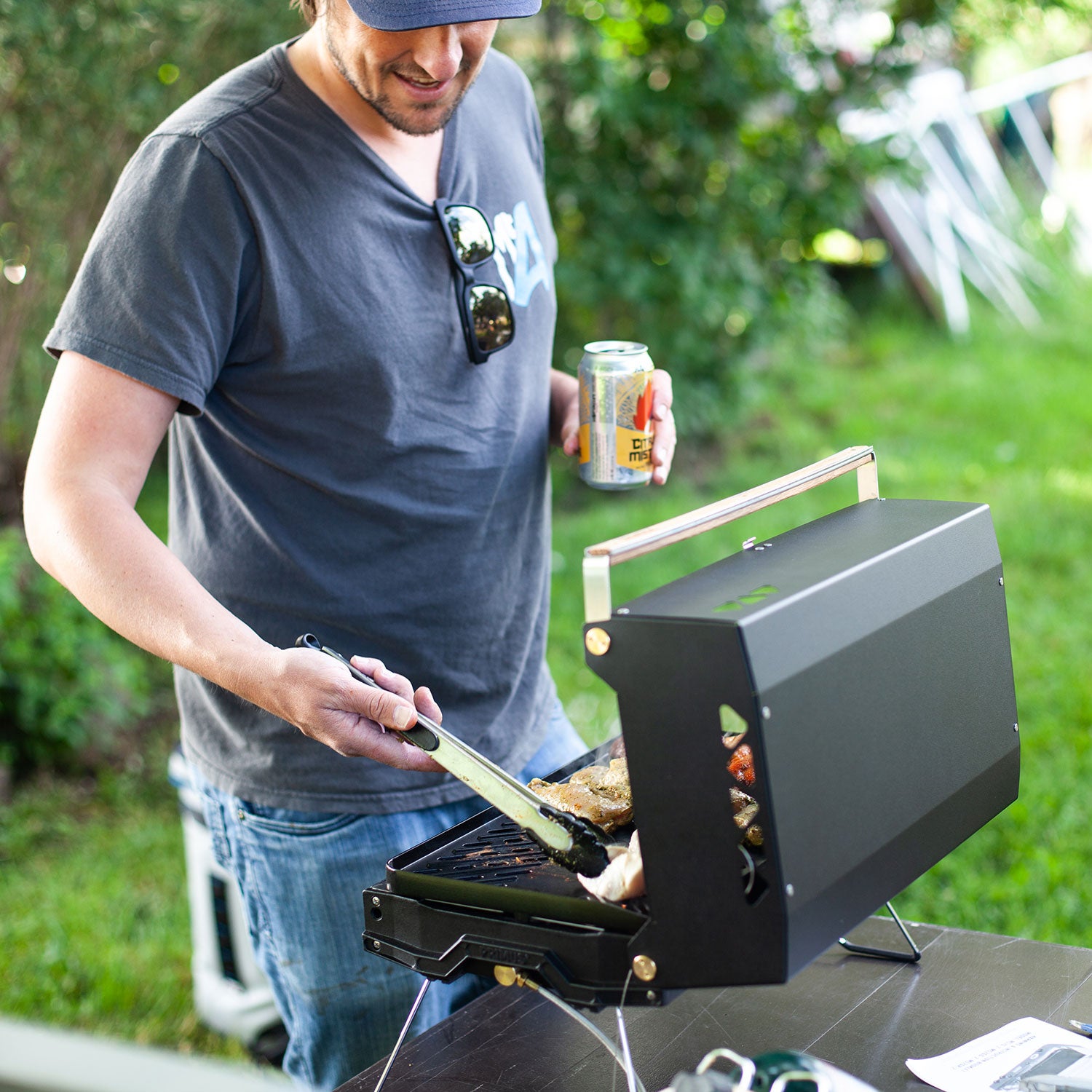Sure, the first day of summer isnÔÇÖt until later in June, but IÔÇÖm ready to welcome it with gin and tonics, swimming hole sessions, and, of course, grilling. Your barbecue doesnÔÇÖt have to be limited to the backyardÔÇöbringing it into the woods, by a river, or next to a lake can be tricky, but itÔÇÖs well worth the effort. In the name of journalism, I put three portable gas grills to the test to find out which should become a permanent fixture in your car camping and traveling setup.
The Contenders
Coleman Road Trip LXE Propane Grill ($150)
The is the top-rated camping grill on Amazon, a version of this grill won , and it consistently popped up toward the top of other tests in my research.
Camp Chef Rainier CamperÔÇÖs Combo ($136)
This is of my all-time favorite camp stove. I wrote an ode to its predecessor, which I used as my only stove when I lived out of my truck for years. While I know itÔÇÖs supremely practical as a stove-grill combo, I wanted to see how the current versionÔÇÖs grill stood up to its competitors.
Primus Kuchoma Grill ($135)
The is a new, exciting, and beautiful little product. I was struck by how well the bare-bones grill worked when I tested it for this yearÔÇÖs Summer┬áBuyerÔÇÖs Guide and have received compliments on its looks half a dozen times.
The Test
To pit these stoves head to head, I used them during a Memorial Day barbecue for about 20 people at a friendÔÇÖs house. To gauge how they handled different types of meat, I cooked 20 boneless chicken thighs, six boneless-skinless chicken breasts, nine top sirloin steaks, and eight hamburgers. I spread the meat out as evenly as I could between the grills (the Coleman has nearly twice the space of the Primus) and made sure to cook at least two of each type of meat on each grill. Prior to cooking, I fired up the grills on high and let them rip for 30 minutes to see how hot each got. I used the same Coleman 16-ounce propane canister on each grill and noted how easy they were to set up, transport, and clean.
The Results

The Winner: Primus Kuchoma Grill
The Kuchoma won for two reasons: simplicity and even cooking. ÔÇťItÔÇÖs like the hibachi grill I grew up using,ÔÇŁ said one guest, whoÔÇÖs in his sixties. You control the heat with one dial that sits on the regulator. This made dialing in the midrange temperatures tricky, given the lack of temperature markings, but it worked fine for cranking up the heat or putting it on low. The 17.5-by-12-inch surface was the smallest I tested and would have been a challenge to grill for all 20 guests, but it easily fit a chicken breast, four thighs, and a steakÔÇöplenty for two families at a campout.
The Kuchoma cooked food the most evenly. The nonstick grate spread the heat across the cook surface without allowing the flame to char the meat too much (while still delivering those coveted grill marks). The thighs that came off the Kuchoma were the best things I cooked all eveningÔÇöother guests agreed. At an 8,500 BTU output, the Kuchoma didnÔÇÖt get quite hot enough to produce a nice sear on the steaks (a piece of cake with the Rainier), but unless you want to dabble with extreme heat, the Kuchoma has all the necessary cooking chops.

#2. Coleman Road Trip LXE Propane Grill
This grill delivers quite a bit for the money. Case in point: Its price is comparable to the other two stoves, yet it looks and acts more like a full-size backyard barbecue than a camp grill. The LXEÔÇÖs size was both its strength (the two burners and 285 square inches of cooking area meant I could have cooked for the entire party with this grill alone) but also its weakness. It was a bit clunky and tough to fit in the trunk of my Toyota Camry, and youÔÇÖd be hard-pressed to fit it in the trunk of any sedan with a familyÔÇÖs worth of camping gear. The two burners allowed for different heat levelsÔÇöI turned one on low to keep the cooked steaks warm while I waited for guests to grab foodÔÇöbut neither was able to bring the heat as hot as I expected, even with each burner putting out 10,000 BTUs. Also, the grill grate couldnÔÇÖt hold heat like the Kuchoma or Rainier, which prevented me from getting a solid sear on the steaks. The upshot: Plenty of real estate and two burners, but the beefy size and long setup time make the Coleman feel more home as a backyard grill than one for camping.

#3. Camp Chef Rainier CamperÔÇÖs Combo
The Rainier had the opposite problem of the other two: It could get a little too hot for everything but the steaks, even with the same 10,000 BTU output as the Coleman. So much so that the grate warped after half an hour at full blast. It was easy enough to bend back into shape, but that cost this grill some points. The Rainier was a champ, however, when it came to the red meatÔÇöit created a beautiful sear on the steaks as they cooked to a perfect medium-rare, and it easily managed grease from the burgers, thanks to the drip tray. The fact that it has a single-burner stove next to the grill (and comes with a griddle that can swap in for the grill) means you can use this as the only┬ástove for all your camp-cooking needs. The CamperÔÇÖs Combo┬átakes the cake for versatility, but it didnÔÇÖt beat the others for sheer cooking prowess.


